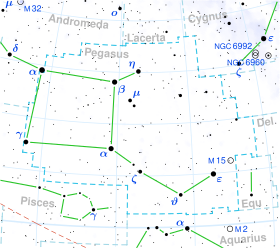| Observation data Epoch J2000.0 Equinox J2000.0 | |
|---|---|
| Constellation | Pegasus |
| Right ascension | 23h 20m 38.24188s[1] |
| Declination | +23° 44′ 25.2098″[1] |
| Apparent magnitude (V) | +4.58[2] |
| Characteristics | |
| Spectral type | A5 Vp[3] A8V(n)kA5mA5 (λ Boo)[4] |
| U−B color index | +0.13[5] |
| B−V color index | +0.17[5] |
| Variable type | δ Sct[6] |
| Astrometry | |
| Radial velocity (Rv) | +15.20±1.6[7] km/s |
| Proper motion (μ) | RA: 29.45±0.33[1] mas/yr Dec.: −9.53±0.27[1] mas/yr |
| Parallax (π) | 20.17 ± 0.40 mas[1] |
| Distance | 162 ± 3 ly (49.6 ± 1.0 pc) |
| Absolute magnitude (MV) | 1.10[2] |
| Details | |
| Mass | 2.14[8] M☉ |
| Radius | 2.8[9] R☉ |
| Luminosity | 32[8] L☉ |
| Surface gravity (log g) | 3.88[10] cgs |
| Temperature | 7,709[8] K |
| Metallicity [Fe/H] | −0.28[2] dex |
| Rotational velocity (v sin i) | 149[8] km/s |
| Other designations | |
| Database references | |
| SIMBAD | data |
Tau Pegasi (τ Pegasi, abbreviated Tau Peg, τ Peg), formally named Salm /ˈsɑːm/,[11] is a magnitude 4.6 star 162 light years away in the constellation of Pegasus. With about twice the mass of the Sun and thirty times as luminous, it is a δ Scuti variable star with its brightness changing by a few hundredths of a magnitude over about an hour.
- ^ a b c d e van Leeuwen, F. (November 2007), "Validation of the new Hipparcos reduction", Astronomy and Astrophysics, 474 (2): 653–664, arXiv:0708.1752, Bibcode:2007A&A...474..653V, doi:10.1051/0004-6361:20078357, S2CID 18759600
- ^ a b c Anderson, E.; Francis, Ch. (2012). "XHIP: An extended hipparcos compilation". Astronomy Letters. 38 (5): 331. arXiv:1108.4971. Bibcode:2012AstL...38..331A. doi:10.1134/S1063773712050015. S2CID 119257644. Vizier catalog entry
- ^ Hoffleit, D.; Warren, W. H. (1995). "VizieR Online Data Catalog: Bright Star Catalogue, 5th Revised Ed. (Hoffleit+, 1991)". VizieR On-line Data Catalog: V/50. Originally Published in: 1964BS....C......0H. 5050. Bibcode:1995yCat.5050....0H.
- ^ Griffin, R. E.; Gray, R. O.; Corbally, C. J. (2012). "The composite-spectrum binary hypothesis does not explain the λ Bootis stars". Astronomy and Astrophysics. 547: A8. Bibcode:2012A&A...547A...8G. doi:10.1051/0004-6361/201219112. S2CID 120300949.
- ^ a b Mermilliod, J. C. (2006). "VizieR Online Data Catalog: Homogeneous Means in the UBV System (Mermilliod 1991)". VizieR On-line Data Catalog: II/168. Originally Published in: Institut d'Astronomie. 2168. Bibcode:2006yCat.2168....0M.Vizier catalog entry
- ^ Samus, N. N.; Durlevich, O. V.; et al. (2009). "VizieR Online Data Catalog: General Catalogue of Variable Stars (Samus+ 2007-2013)". VizieR On-line Data Catalog: B/GCVS. Originally Published in: 2009yCat....102025S. 1. Bibcode:2009yCat....102025S.
- ^ Gontcharov, G. A. (2006). "Pulkovo Compilation of Radial Velocities for 35 495 Hipparcos stars in a common system". Astronomy Letters. 32 (11): 759–771. arXiv:1606.08053. Bibcode:2006AstL...32..759G. doi:10.1134/S1063773706110065. S2CID 119231169.
- ^ a b c d Zorec, J.; Royer, F. (2012). "Rotational velocities of A-type stars". Astronomy & Astrophysics. 537: A120. arXiv:1201.2052. Bibcode:2012A&A...537A.120Z. doi:10.1051/0004-6361/201117691. S2CID 55586789. Vizier catalog entry
- ^ Allende Prieto, C.; Lambert, D. L. (1999). "Fundamental parameters of nearby stars from the comparison with evolutionary calculations: Masses, radii and effective temperatures". Astronomy and Astrophysics. 352: 555–562. arXiv:astro-ph/9911002. Bibcode:1999A&A...352..555A. Vizier catalog entry
- ^ David, Trevor J.; Hillenbrand, Lynne A. (2015). "The Ages of Early-Type Stars: Strömgren Photometric Methods Calibrated, Validated, Tested, and Applied to Hosts and Prospective Hosts of Directly Imaged Exoplanets". The Astrophysical Journal. 804 (2): 146. arXiv:1501.03154. Bibcode:2015ApJ...804..146D. doi:10.1088/0004-637X/804/2/146. S2CID 33401607. Vizier catalog entry
- ^ "Naming Stars". IAU.org. Retrieved 16 December 2017.
